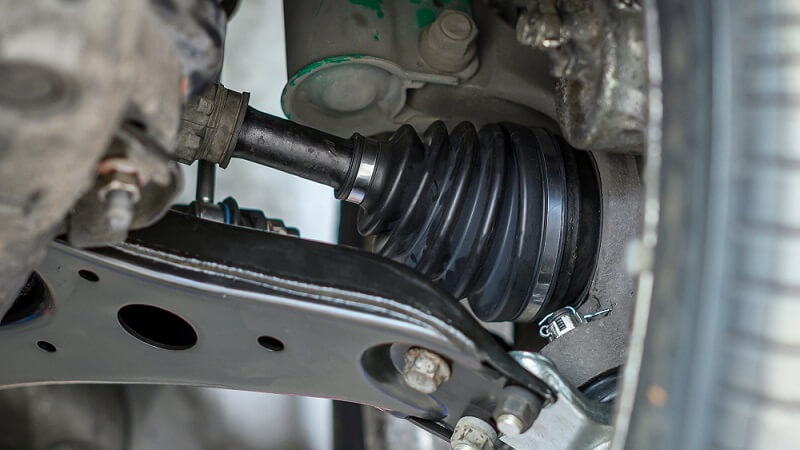Imagine hearing from your mechanic, “Your tire is flat. You’ll need to replace it.” Those words are clear and direct, making it easy to comprehend the issue. However, facing the statement, “Your CV joint and CV boot are damaged and need repair,” might leave you perplexed. This guide will break down the complexities surrounding CV joints and boots, providing you with the knowledge you need to make informed decisions about their repair and maintenance. ¹
Understanding CV Joints and CV Boots
CV, or constant velocity, joints play a crucial role in front-wheel drive vehicles and in some cars with independent rear suspension and four-wheel or all-wheel drive systems. The primary function of a CV axle is to transfer engine power to the drive wheels at a consistent speed, regardless of the road conditions. This ensures a safe and comfortable driving experience. ¹
CV axles utilise two CV joints-an inner and an outer joint to achieve those above. The CV joints are covered by rubber boots, known as CV boots, designed to withstand extreme temperatures and driving conditions. The boots are protective layers, keeping the CV joints lubricated with grease. While CV boots are built to last 160,000 kilometres or more, they are susceptible to wear and tear due to exposure to the elements. ¹
Common Causes of CV Joint Failure
CV axles rarely fail; the CV joints typically face issues, often stemming from a damaged CV boot. When a CV boot tears or fails, it leads to a leakage of the lubricating grease, leaving the CV joints exposed to dirt, grime, and debris from the road. The outer joint is more prone to failure due to increased exposure to external elements and higher usage. ¹
Signs of CV Boot Failure
To prevent costly problems associated with CV joint damage, it’s crucial to recognise the warning signs of CV boot failure:
1. Grease Leak: The most common symptom of a CV boot issue is a visible grease leak, either inside the wheel or on the chassis, resulting from a cracked or brittle rubber boot. ¹
2. Noises: Clicking, popping, or grinding sounds during turns may indicate a loose CV joint, often requiring replacement. ¹
3. Vibrations: Damaged CV boots allow debris to reach the CV axle, causing vibrations that can be felt through the steering wheel, especially at certain speeds. ¹
Importance of Regular CV Boot Inspection
Given the critical role of CV boots in protecting CV joints, routine inspections are essential to ensure their longevity. Inspecting CV boots for potential damage and addressing issues can prevent more significant problems. ¹
How to Inspect the CV Axle
If you suspect an issue with your CV axle, a manual inspection at home can provide some insights. Here’s a simple guide:
- Park your car on level ground with the emergency brake engaged. ¹
- Slide underneath the vehicle to inspect both CV axles simultaneously and one at a time by sliding underneath in front of each wheel. ¹
- Examine the rubber of each CV boot for cracks, leaks, or damage. Grease leakage is a clear sign of wear. ¹
- Test the CV joints by driving in a circle on a flat surface. Listen for clicking or popping sounds, especially during turns, as this may indicate joint damage. ¹
Seeking Professional Assistance
While a manual inspection can offer some insights, seeking professional assistance is essential if you suspect CV joint or CV boot issues. Professionals can conduct a more thorough examination and provide accurate diagnoses, ensuring your vehicle remains in optimal condition. ¹
Understanding the intricacies of CV joints and CV boots empowers drivers to make informed decisions about their vehicle’s maintenance and repair. Regular inspections, prompt attention to warning signs, and seeking professional assistance are key practices to ensure the longevity and reliability of your vehicle’s CV axles. Prioritise the health of your CV joints and boots for a smoother and safer driving experience. ¹
Disclaimer:
The article aims to provide South African motorists with everything about CV boots and CV joint repairs.
Please always consult professionals when servicing or experiencing any trouble with your car. If you want to buy car insurance, only do so through a certified financial advisor for professional advice and to make sure the product is right for you, and you understand all the terms and conditions in your policy.
Contact PMD for more information regarding affordable, comprehensive car insurance with fixed premiums* and a reduce-to-zero excess*. T’s and C’s apply.
Sources:
This article was prepared by Eric Sandmann in his personal capacity. The views and opinions expressed in this article are the author’s own. The views and opinions in the article should not be attributed to anyone but the author unless expressly stated. Nothing in this article should be relied upon as advice, this publication is presented for informational purposes only. No person should act or refrain from acting in reliance on any information found in this article, without first obtaining proper financial advice from the appropriate professional. The author makes no claims, promises or guarantees about the accuracy, or completeness, of any information linked from, referred to, or contained in this article. The author reserves the right, to edit and change the content of this article.
